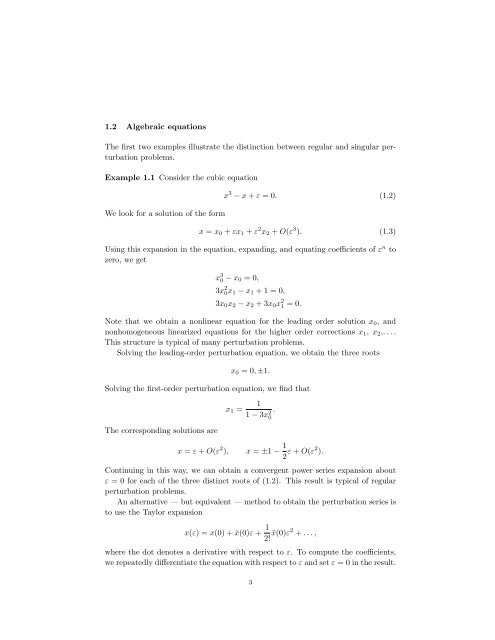Asymptotic Analysis and Singular Perturbation Theory
Asymptotic Analysis and Singular Perturbation Theory
Asymptotic Analysis and Singular Perturbation Theory
Create successful ePaper yourself
Turn your PDF publications into a flip-book with our unique Google optimized e-Paper software.
1.2 Algebraic equations<br />
The first two examples illustrate the distinction between regular <strong>and</strong> singular perturbation<br />
problems.<br />
Example 1.1 Consider the cubic equation<br />
We look for a solution of the form<br />
x 3 − x + ε = 0. (1.2)<br />
x = x0 + εx1 + ε 2 x2 + O(ε 3 ). (1.3)<br />
Using this expansion in the equation, exp<strong>and</strong>ing, <strong>and</strong> equating coefficients of ε n to<br />
zero, we get<br />
x 3 0 − x0 = 0,<br />
3x 2 0x1 − x1 + 1 = 0,<br />
3x0x2 − x2 + 3x0x 2 1 = 0.<br />
Note that we obtain a nonlinear equation for the leading order solution x0, <strong>and</strong><br />
nonhomogeneous linearized equations for the higher order corrections x1, x2,. . . .<br />
This structure is typical of many perturbation problems.<br />
Solving the leading-order perturbation equation, we obtain the three roots<br />
x0 = 0, ±1.<br />
Solving the first-order perturbation equation, we find that<br />
The corresponding solutions are<br />
x1 =<br />
1<br />
1 − 3x 2 0<br />
x = ε + O(ε 2 ), x = ±1 − 1<br />
2 ε + O(ε2 ).<br />
Continuing in this way, we can obtain a convergent power series expansion about<br />
ε = 0 for each of the three distinct roots of (1.2). This result is typical of regular<br />
perturbation problems.<br />
An alternative — but equivalent — method to obtain the perturbation series is<br />
to use the Taylor expansion<br />
x(ε) = x(0) + ˙x(0)ε + 1<br />
2! ¨x(0)ε2 + . . . ,<br />
where the dot denotes a derivative with respect to ε. To compute the coefficients,<br />
we repeatedly differentiate the equation with respect to ε <strong>and</strong> set ε = 0 in the result.<br />
3<br />
.
















